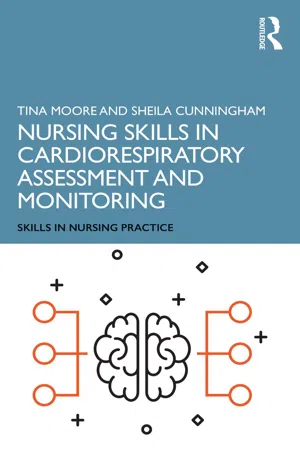
Nursing Skills in Cardiorespiratory Assessment and Monitoring
- 104 pages
- English
- ePUB (mobile friendly)
- Available on iOS & Android
Nursing Skills in Cardiorespiratory Assessment and Monitoring
About this book
Organisms need to be able to maintain nearly constant internal environments in order to survive, grow and function effectively and efficiently. By maintaining homeostasis, humans remain healthy, strong and protected from the invasion of foreign organisms, such as viruses, bacteria and fungi. This practical pocket guide covers:
• the anatomy and physiology of cardiovascular system vital signs
• recognition of common arrhythmias and important skills for cardiovascular health cannulation and venepuncture
• the anatomy and physiology of the respiratory system
• skills related to addressing respiratory problems.
This competency-based text covers relevant key concepts, anatomy and physiology, lifespan matters, assessment and nursing skills. To support your learning, it also includes learning outcomes, concept map summaries, activities, questions and scenarios with sample answers and critical reflection thinking points.
Quick and easy to reference, this short, clinically-focused guide is ideal for use on placements or for revision. It is suitable for pre-registration nurses, students on the nursing associate programme and newly qualified nurses.
Frequently asked questions
- Essential is ideal for learners and professionals who enjoy exploring a wide range of subjects. Access the Essential Library with 800,000+ trusted titles and best-sellers across business, personal growth, and the humanities. Includes unlimited reading time and Standard Read Aloud voice.
- Complete: Perfect for advanced learners and researchers needing full, unrestricted access. Unlock 1.4M+ books across hundreds of subjects, including academic and specialized titles. The Complete Plan also includes advanced features like Premium Read Aloud and Research Assistant.
Please note we cannot support devices running on iOS 13 and Android 7 or earlier. Learn more about using the app.
Information
CHAPTER 1
Anatomy and physiology of cardiorespiratory system
Overview
Link to Future Nurse Proficiencies (NMC 2018)
Expected knowledge
- The organs within the cardiovascular and respiratory systems
- Basic cellular needs and the concept of homeostasis
- The purpose of ‘vital signs’ and parameters within these for health.
Introduction
the monitoring and measurement of vital signs and clinical assessment are core essential skills for all health care practitioners working with infants, children and young people. This guidance applies to professionals who work in acute care settings, as well as those who work in GP surgeries, walk-in clinics, telephone advice and triage services, schools and other community settings.
Content
| Cardiovascular functions | Control of blood pressure and heart rate | Regulation and homeostatic role of cardiovascular and respiratory systems |
| Respiratory functions | Control of breathing | Volumes and capacities |
Learning outcomes
- Revisit the anatomical structures of the cardiorespiratory systems
- Differentiate lung volumes and capacities and why they are important in health monitoring
- Consolidate mechanisms and control of circulation and respiration
- Differentiate external and internal respiration and tissue needs including the role of microcirculation
- Reflect on knowledge of physiology and connections with nursing skills of monitoring vital signs.
Key background
Table of contents
- Cover
- Half-Title
- Series
- Title
- Copyright
- Contents
- List of Figures
- Introduction to the Skills in Nursing Practice series
- Introduction and overview
- Chapter 1 Anatomy and physiology of cardiorespiratory system
- Chapter 2 Vital signs
- Chapter 3 Oxygenation
- Chapter 4 Advanced respiratory skills
- Chapter 5 Cardiovascular skills
- Chapter 6 Cannulation and venepuncture
- Bibliography
- Index